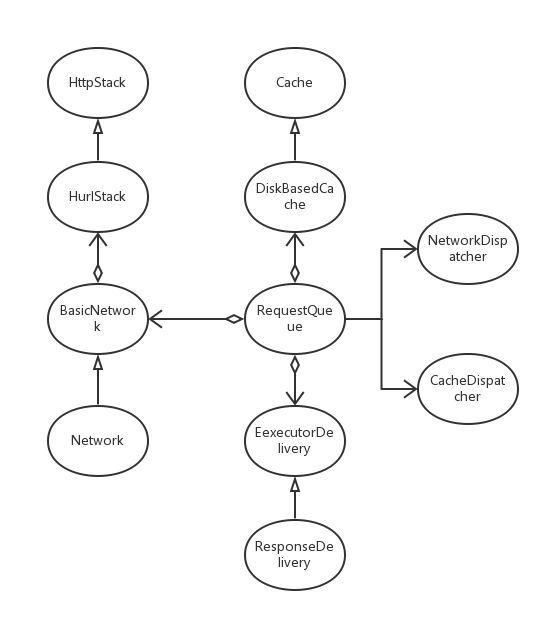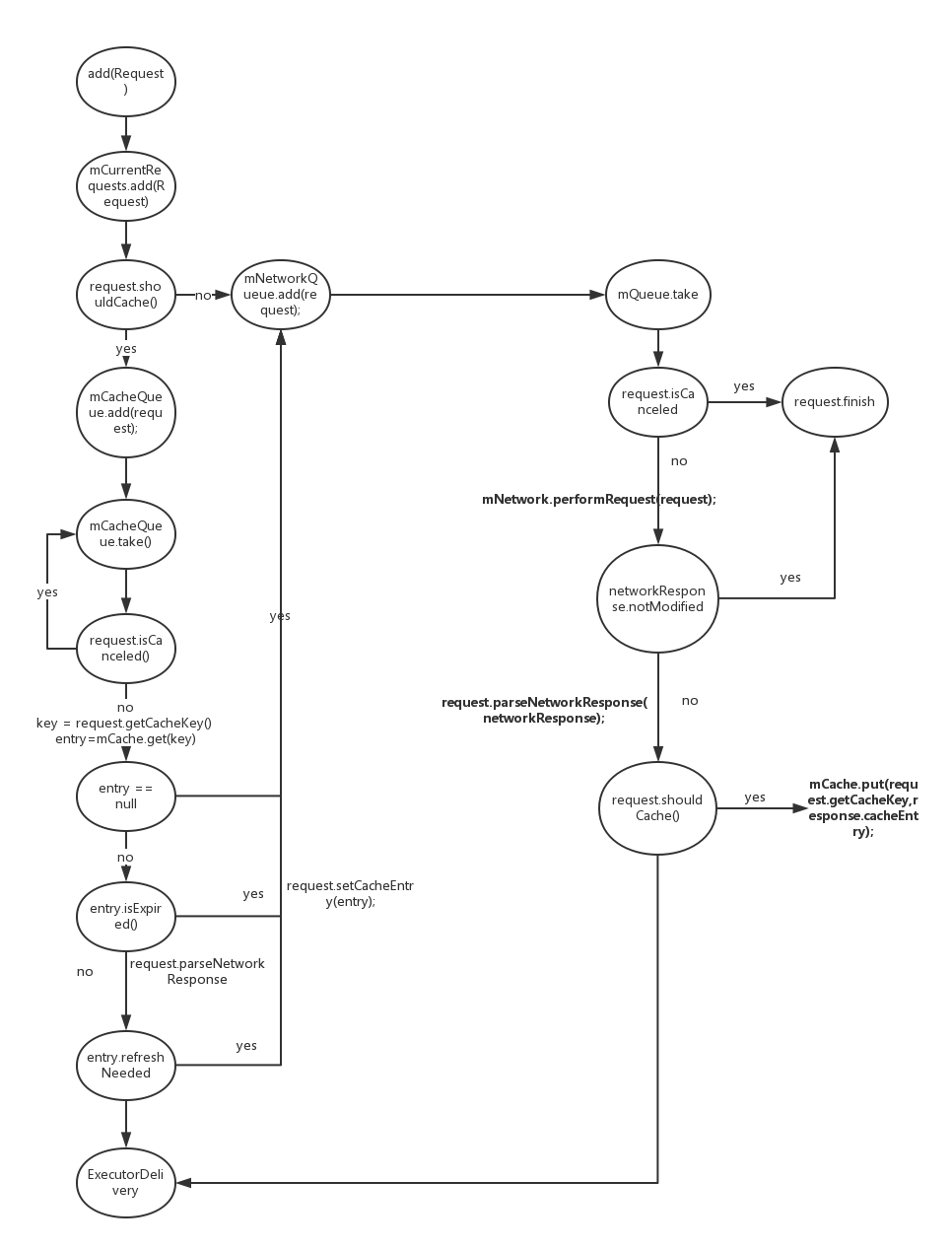首先看下RequestQueue的实例化过程.从这里可以看出来,volley是自带有硬存的,并且当adk版本低于9时,网络交互运用的是HttpClient,大于9时运用的是HttpURLConnection
public static RequestQueue newRequestQueue(Context context, HttpStack stack) {
File cacheDir = new File(context.getCacheDir(), DEFAULT_CACHE_DIR);
String userAgent = "volley/0";
try {
String packageName = context.getPackageName();
PackageInfo info = context.getPackageManager().getPackageInfo(packageName, 0);
userAgent = packageName + "/" + info.versionCode;
} catch (NameNotFoundException e) {
}
if (stack == null) {
if (Build.VERSION.SDK_INT >= 9) {
stack = new HurlStack();
} else {
// Prior to Gingerbread, HttpUrlConnection was unreliable.
// See: http://android-developers.blogspot.com/2011/09/androids-http-clients.html
stack = new HttpClientStack(AndroidHttpClient.newInstance(userAgent));
}
}
Network network = new BasicNetwork(stack);
RequestQueue queue = new RequestQueue(new DiskBasedCache(cacheDir), network);
queue.start();
return queue;
}这里配张图讲解下ResquestQueue的构成。

接下来看看RequestQueue的全局变量:
//用于为每个request生成单调递增的编号
private AtomicInteger mSequenceGenerator = new AtomicInteger();
//暂存区域,存放已经有一个重复的请求request在发送的request。
//正在发送的request并不会保存在此队列中,当没有重复的request时,get(cacheKey)返回的是null。
//containsKey(cacheKey) 指向的是与正在发送的request拥有相同缓存键的队列
private final Map<String, Queue<Request<?>>> mWaitingRequests =
new HashMap<String, Queue<Request<?>>>();
//所有调用了RequestQueue.add的request都在此队列中。
private final Set<Request<?>> mCurrentRequests = new HashSet<Request<?>>();
//缓存队列
private final PriorityBlockingQueue<Request<?>> mCacheQueue =
new PriorityBlockingQueue<Request<?>>();
//存放正在与网络交互的request
private final PriorityBlockingQueue<Request<?>> mNetworkQueue =
new PriorityBlockingQueue<Request<?>>();
//默认与网络交互开启的线程数量
private static final int DEFAULT_NETWORK_THREAD_POOL_SIZE = 4;
//硬盘缓存
private final Cache mCache;
//用于执行网络请求
private final Network mNetwork;
//用于当网络请求返回时的响应
private final ResponseDelivery mDelivery;
//执行网络交互的线程
private NetworkDispatcher[] mDispatchers;
//缓存线程
private CacheDispatcher mCacheDispatcher;
private List<RequestFinishedListener> mFinishedListeners =
new ArrayList<RequestFinishedListener>();接下来看一下ReqestQueue的add方法:
public <T> Request<T> add(Request<T> request) {
// Tag the request as belonging to this queue and add it to the set of current requests.
request.setRequestQueue(this);
synchronized (mCurrentRequests) {
mCurrentRequests.add(request);
}
// Process requests in the order they are added.
request.setSequence(getSequenceNumber());
request.addMarker("add-to-queue");
//当request并不进行缓存时,直接插入mNetworkQueue
if (!request.shouldCache()) {
mNetworkQueue.add(request);
return request;
}
// 当有与request的cacheKey相同的request正在与网络交互时,将后进入RequestQueue的request插入mWaitingRequest
synchronized (mWaitingRequests) {
String cacheKey = request.getCacheKey();
if (mWaitingRequests.containsKey(cacheKey)) {
// There is already a request in flight. Queue up.
Queue<Request<?>> stagedRequests = mWaitingRequests.get(cacheKey);
if (stagedRequests == null) {
stagedRequests = new LinkedList<Request<?>>();
}
stagedRequests.add(request);
mWaitingRequests.put(cacheKey, stagedRequests);
if (VolleyLog.DEBUG) {
VolleyLog.v("Request for cacheKey=%s is in flight, putting on hold.", cacheKey);
}
} else {
// 当mWaitiingRequest中没有cacheKey这个键时,插入键值对cacheKey-null,表明这里已有request正在与网络进行交互
mWaitingRequests.put(cacheKey, null);
mCacheQueue.add(request);
}
return request;
}
}这个方法实际上是在调用Volley.newRequestQueue时调用的。可以看到的是这里仅是开启了线程。
public void start() {
stop(); // Make sure any currently running dispatchers are stopped.
// Create the cache dispatcher and start it.
mCacheDispatcher = new CacheDispatcher(mCacheQueue, mNetworkQueue, mCache, mDelivery);
mCacheDispatcher.start();
// Create network dispatchers (and corresponding threads) up to the pool size.
for (int i = 0; i < mDispatchers.length; i++) {
NetworkDispatcher networkDispatcher = new NetworkDispatcher(mNetworkQueue, mNetwork,
mCache, mDelivery);
mDispatchers[i] = networkDispatcher;
networkDispatcher.start();
}
}停用RequestQueue也是调用各线程的interrupt方法
public void stop() {
if (mCacheDispatcher != null) {
mCacheDispatcher.quit();
}
for (int i = 0; i < mDispatchers.length; i++) {
if (mDispatchers[i] != null) {
mDispatchers[i].quit();
}
}
}接下来分析一下缓存线程CacheDispatcher :
它接受的参数有四个:mCacheQueue(缓存队列), mNetworkQueue(网络交互队列), mCache(硬盘缓存), mDelivery(交互完成后回调)。
public void run() {
if (DEBUG) VolleyLog.v("start new dispatcher");
Process.setThreadPriority(Process.THREAD_PRIORITY_BACKGROUND);
// Make a blocking call to initialize the cache.
mCache.initialize();
while (true) {
try {
// 从缓存队列中取出request,此处会堵塞
final Request<?> request = mCacheQueue.take();
request.addMarker("cache-queue-take");
// If the request has been canceled, don't bother dispatching it.
if (request.isCanceled()) {
request.finish("cache-discard-canceled");
continue;
}
// 从硬盘缓存中取出该request对应的缓存
Cache.Entry entry = mCache.get(request.getCacheKey());
if (entry == null) {
request.addMarker("cache-miss");
// Cache miss; send off to the network dispatcher.
mNetworkQueue.put(request);
continue;
}
// 缓存过期
if (entry.isExpired()) {
request.addMarker("cache-hit-expired");
request.setCacheEntry(entry);
mNetworkQueue.put(request);
continue;
}
// We have a cache hit; parse its data for delivery back to the request.
request.addMarker("cache-hit");
Response<?> response = request.parseNetworkResponse(
new NetworkResponse(entry.data, entry.responseHeaders));
request.addMarker("cache-hit-parsed");
if (!entry.refreshNeeded()) {
// Completely unexpired cache hit. Just deliver the response.
mDelivery.postResponse(request, response);
} else {
// Soft-expired cache hit. We can deliver the cached response,
// but we need to also send the request to the network for
// refreshing.
request.addMarker("cache-hit-refresh-needed");
request.setCacheEntry(entry);
// Mark the response as intermediate.
response.intermediate = true;
// Post the intermediate response back to the user and have
// the delivery then forward the request along to the network.
mDelivery.postResponse(request, response, new Runnable() {
@Override
public void run() {
try {
mNetworkQueue.put(request);
} catch (InterruptedException e) {
// Not much we can do about this.
}
}
});
}
} catch (InterruptedException e) {
// We may have been interrupted because it was time to quit.
if (mQuit) {
return;
}
continue;
}
}
}
网络交互线程mDispatchers接受的参数有四个:mNetworkQueue(网络交互队列), mNetwork(执行网络交互), mCache(硬盘缓存), mDelivery(交互完成后回调)。
public void run() {
Process.setThreadPriority(Process.THREAD_PRIORITY_BACKGROUND);
while (true) {
long startTimeMs = SystemClock.elapsedRealtime();
Request<?> request;
try {
//从队列中取出request,此处会堵塞。
request = mQueue.take();
} catch (InterruptedException e) {
// We may have been interrupted because it was time to quit.
if (mQuit) {
return;
}
continue;
}
try {
request.addMarker("network-queue-take");
// If the request was cancelled already, do not perform the
// network request.
if (request.isCanceled()) {
request.finish("network-discard-cancelled");
continue;
}
addTrafficStatsTag(request);
// 执行网络交互
NetworkResponse networkResponse = mNetwork.performRequest(request);
request.addMarker("network-http-complete");
// If the server returned 304 AND we delivered a response already,
// we're done -- don't deliver a second identical response.
if (networkResponse.notModified && request.hasHadResponseDelivered()) {
request.finish("not-modified");
continue;
}
//解析返回来的数据
Response<?> response = request.parseNetworkResponse(networkResponse);
request.addMarker("network-parse-complete");
//将缓存写入
// TODO: Only update cache metadata instead of entire record for 304s.
if (request.shouldCache() && response.cacheEntry != null) {
mCache.put(request.getCacheKey(), response.cacheEntry);
request.addMarker("network-cache-written");
}
// Post the response back.
request.markDelivered();
mDelivery.postResponse(request, response);
} catch (VolleyError volleyError) {
volleyError.setNetworkTimeMs(SystemClock.elapsedRealtime() - startTimeMs);
parseAndDeliverNetworkError(request, volleyError);
} catch (Exception e) {
VolleyLog.e(e, "Unhandled exception %s", e.toString());
VolleyError volleyError = new VolleyError(e);
volleyError.setNetworkTimeMs(SystemClock.elapsedRealtime() - startTimeMs);
mDelivery.postError(request, volleyError);
}
}
}最后用一张图概括全流程:























 420
420











 被折叠的 条评论
为什么被折叠?
被折叠的 条评论
为什么被折叠?








